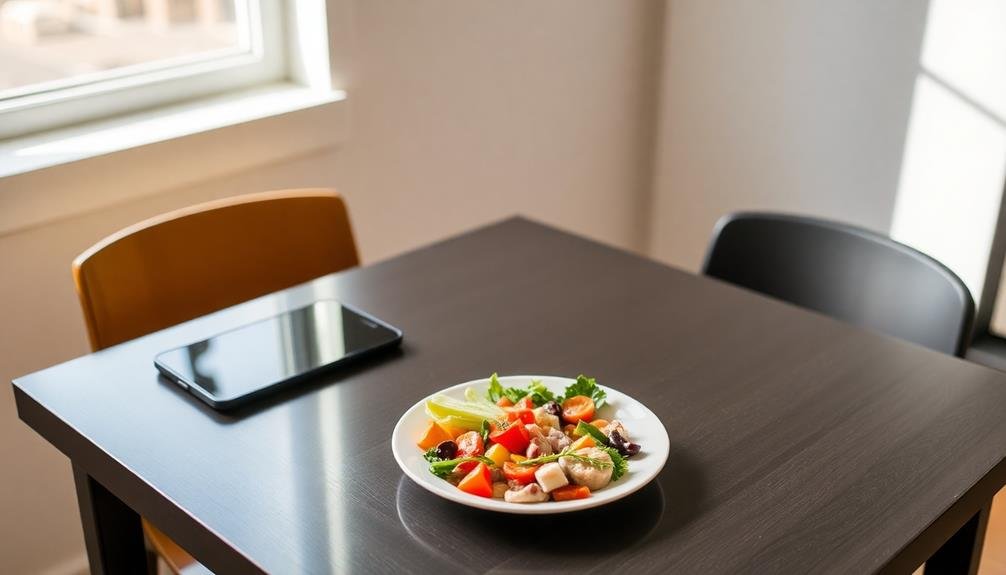Mindful eating can greatly reduce anxiety around food and meals. Start by practicing slow, deliberate chewing, savoring each bite for 20-30 seconds. Engage all five senses to fully experience your food's colors, aromas, flavors, textures, and sounds. Eliminate distractions like screens or multitasking to focus solely on your meal. Before eating, take a moment to express gratitude for your food and those involved in its production. Finally, tune into your body's hunger and fullness cues, using a 1-10 scale to gauge your satiety. These techniques not only ease anxiety but also foster a healthier relationship with food. Discover how these practices can transform your eating habits and overall well-being.
Key Takeaways
- Practice slow, deliberate chewing to focus on the present moment and enhance flavor appreciation, reducing anxiety.
- Engage all five senses while eating to deepen your connection with food and promote relaxation.
- Eliminate distractions during meals to create a calm eating environment and reduce anxiety-inducing stimuli.
- Express gratitude for your food to shift your mindset positively and foster a sense of contentment.
- Observe hunger and fullness cues to develop a healthier relationship with food and reduce anxiety around eating.
Practice Slow, Deliberate Chewing

When you practice slow, deliberate chewing, you're taking the first step toward mindful eating. This technique helps you focus on the present moment and fully experience your food. Start by taking smaller bites and chewing each mouthful 20 to 30 times before swallowing. This allows you to savor the flavors, textures, and aromas of your meal.
As you chew, pay attention to how the food changes in your mouth. Notice the breakdown of textures and the release of flavors. This process not only aids digestion but also helps you become more aware of your body's hunger and fullness cues.
You'll likely find that you eat less overall, as your brain has more time to register satiety signals. Slow chewing also promotes better nutrient absorption and can reduce digestive discomfort. It gives your saliva more time to break down food, easing the workload on your stomach and intestines.
Engage All Five Senses

A feast for the senses awaits when you engage all five senses during your meal. By focusing on sight, smell, taste, touch, and sound, you'll deepen your connection with food and reduce anxiety. Start by visually appreciating your meal's colors, textures, and presentation. Inhale deeply, savoring the aroma before taking your first bite. As you eat, pay attention to the various flavors and how they interact on your palate.
Notice the texture of the food in your mouth and how it changes as you chew. Listen to the sounds of your eating experience, from the crunch of vegetables to the sizzle of a hot dish. This multisensory approach helps you stay present and fully appreciate your meal.
| Sense | Focus On | Benefits |
|---|---|---|
| Sight | Colors, presentation | Enhances anticipation |
| Smell | Aromas, fragrances | Stimulates appetite |
| Taste | Flavors, combinations | Increases satisfaction |
Eliminate Distractions While Eating

Three common distractions can derail your mindful eating practice: screens, multitasking, and noise. To truly engage in mindful eating, you'll need to eliminate these distractions.
First, turn off your TV, put away your phone, and close your laptop. These screens pull your attention away from your meal and can lead to mindless overeating. Instead, focus on the food in front of you.
Next, avoid multitasking during meals. Don't eat while working, driving, or doing other activities. Dedicate your mealtime solely to eating and enjoying your food. This allows you to fully experience the flavors, textures, and nourishment your meal provides.
Express Gratitude for Food

Before taking your first bite, pause to express gratitude for your meal. This simple act can shift your mindset and deepen your connection with the food you're about to consume. Acknowledge the effort that went into growing, harvesting, and preparing your meal. Consider the farmers, transporters, and cooks who contributed to bringing this nourishment to your plate.
You can express gratitude silently or aloud, depending on your comfort level and surroundings. Focus on the positive aspects of your meal, such as its nutritional value, appealing colors, or enticing aromas. Appreciate the opportunity to nourish your body and mind through this act of eating.
Practicing gratitude for your food can help reduce anxiety by promoting a sense of abundance and contentment. It encourages you to slow down and be present in the moment, counteracting the rushed, distracted eating habits that often contribute to stress.
Observe Hunger and Fullness Cues

Tuning into your body's signals is a crucial aspect of mindful eating. By observing your hunger and fullness cues, you'll develop a deeper connection with your body and make more informed choices about when and how much to eat. This practice can help reduce anxiety around food and promote a healthier relationship with eating.
Start by paying attention to your physical sensations before, during, and after meals. Notice how hunger feels in your body – perhaps as a growling stomach or light-headedness. As you eat, pause periodically to assess your level of fullness. You'll gradually learn to recognize the subtle signs that indicate you're comfortably satisfied.
Here are some tips to help you observe hunger and fullness cues:
- Use a hunger scale from 1 (starving) to 10 (uncomfortably full) to rate your hunger before and after eating.
- Eat slowly and without distractions to better notice your body's signals.
- Stop eating when you feel about 80% full, as it takes time for your brain to register satiety.
Frequently Asked Questions
Can Mindful Eating Help With Weight Loss?
Yes, mindful eating can help with weight loss. When you're more aware of what you're eating, you'll likely make healthier choices, eat slower, and recognize fullness cues. This can lead to reduced calorie intake and better portion control.
How Long Does It Take to Develop Mindful Eating Habits?
It typically takes 21-66 days to form new habits, including mindful eating. You'll notice improvements within weeks, but don't get discouraged if it's not instant. Stay consistent, and you'll gradually develop stronger mindful eating practices.
Are There Specific Foods That Promote Mindful Eating?
You'll find that any food can promote mindful eating. However, foods with complex textures, flavors, or aromas can enhance your mindful experience. Try fruits, nuts, or dark chocolate. They're great for practicing sensory awareness while eating.
Can Mindful Eating Techniques Be Practiced During Social Dining Situations?
Yes, you can practice mindful eating in social settings. Focus on your food, chew slowly, and savor each bite. Engage in conversation between bites, put your utensils down, and pause to appreciate the company and atmosphere.
How Does Mindful Eating Affect Nutrient Absorption and Digestion?
When you practice mindful eating, you're enhancing your body's ability to absorb nutrients and digest food more efficiently. You'll chew more thoroughly, eat slower, and be more aware of your body's signals, improving overall digestion and nutrient uptake.
In Summary
You've now learned five powerful mindful eating techniques to help ease anxiety. By incorporating these practices into your daily meals, you'll cultivate a deeper connection with your food and your body. Remember, it's not about perfection but progress. Start small, be patient with yourself, and gradually build these habits. As you become more aware of your eating patterns, you'll likely find your anxiety diminishing and your overall well-being improving. Embrace this journey towards a more mindful relationship with food.





Leave a Reply